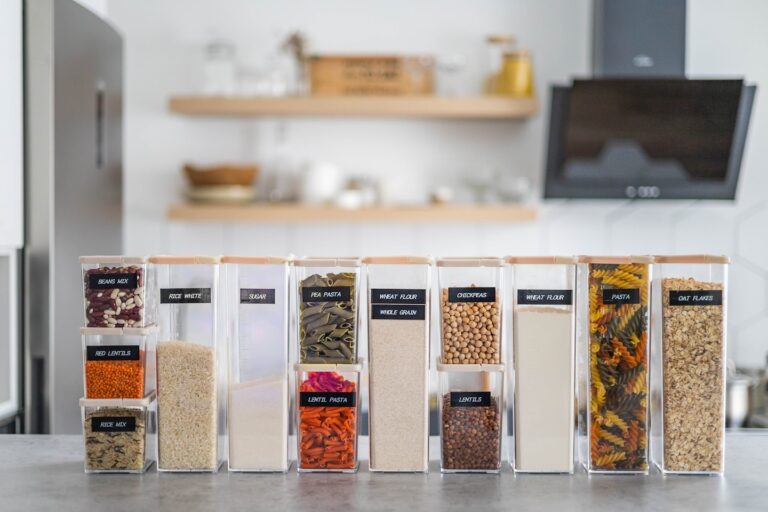Use the classic kitchen triangle (sink, fridge, stove) as a guide for storing your things. Store oils and spices near the stove and place a dish rack next to the sink. If your kitchen is messy, start by taking everything out of your cabinets and fridge and grouping items by category (cake molds, dried pasta). Before putting everything back, get rid of anything that's expired or no longer needed.
Here are some other simple principles to help you tackle the main spaces in your kitchen:
Pantry: Make sure items are visible
Once you've sorted your nonperishable foods and kitchen supplies by category, decide where they're going to go back in. Consider storing similar items together (canned goods, baking ingredients) and labeling the inside of drawers or cabinets to show what goes where.
Being able to easily see and access the items in your pantry (or the cabinet that serves as your pantry) is key. “If you don't have things shoved haphazardly into your cabinets, a quick glance at your pantry will let you know what's in there,” says Dana K. White of A Slob Comes Clean. “That way, you can do some 'shopping' in the kitchen before cooking dinner.”
Organizational tools can also help keep your pantry in order: Store onions and potatoes in clear plastic containers or simple baskets, and arrange spices on a tiered platform (think mouse-sized bleachers). “Turntables are great because you can turn them to get to something at the back of a cabinet,” says Ann Mooney, an organizer in Oakland, California. “They give you a circular solution to a square problem.”
Cabinets: Focus on what you use and how you use it
Prime space in your cabinets — on easy-to-reach shelves or drawers closest to the dishwasher — should hold the plates, cutlery, and utensils you use most often. “Put your silverware in the drawer right next to the dishwasher and your coffee mugs directly above the coffee maker. Distance is key,” says White.
Drawers can be neatly organized with dividers like silverware trays and slim knife blocks, which will also keep items from sliding around and becoming cluttered. If your cupboards don't have pull-out shelves (a common feature in modern kitchens), you can add your own from companies like Rev-a-Shelf, Elfa from the Container Store, or ShelfGenie.
For dishes and glassware you use only a few times a year, like your grandmother's formal china or large serving platters, “find storage somewhere other than the kitchen,” suggests Lower. Store your collection of wine glasses and cocktail swizzle sticks in a dining room sideboard, and advise space-strapped clients to store holiday-only plates and cups in padded ziplock containers in a closet or attic.
The refrigerator: Treat it like a closet
It's easier to organize your fridge if you think of it as a food closet, which means like items will gather together again. “Separate your fridge into separate areas: drinks, meats and cheeses, vegetables,” says Mooney. You can use the drawers that come with your fridge (such as a crisper or produce drawer) or place some clear plastic bins on a shelf to organize.
Lower is a believer in “file, not stack” storage, especially when it comes to the freezer. “Storing things sideways in your drawers gives you better visibility of what's inside,” Lower says. “You can also remove excess packaging from things like frozen pizzas before putting them away, which saves space.”
Regularly check the expiration dates on your refrigerated items and keep an eye out for rotten vegetables and spoiled meat. Some newer smart fridges use AI to monitor food freshness, but you still need to input when you bought that lettuce or the “best before” date on that yogurt.
Countertops: Reduce visual clutter
Anything you keep on your kitchen counters, from your Instant Pot to your knife rack, contributes to visual clutter. “Anything you can do to reduce the amount of stuff on your counters will help make the room look neater,” says Lauer. “Everyone has different tolerance levels, but generally speaking, the less stuff you have on your counters, the easier it is to keep them clean.”
Magazine minimalism may not be achievable in real life, but you can reduce the strain on your countertops by clearing out cabinets for small appliances, swapping your countertop microwave for a pull-out style, and investing in a dish drying rack that folds or rolls up so it can be tucked away and hidden when not in use.
Organize items that you want to keep on your counter into containers or “stations”: Place wooden spoons and spatulas in an oversized jar next to the stove, or create a beverage station by placing mugs, tea bags and sugar tins on a tray next to the coffee machine.
Under the sink or over the stove: make the most of tight spaces
If your kitchen is tight on space, you can turn awkward spaces into storage. “Even if you have plumbing pipes under your sink, you can add drawers or install shelves for other supplies,” says Shannon Kadwell, kitchen and bathroom designer at Anthony Wilder Design/Build in Maryland. Or, you could place a small tension rod the entire length of the under-sink cabinet just in front of the pipes and hang cleaning bottles with the nozzles at the end.
The small cabinet above your range hood is often too hot to store food, but it can hold water bottles. Stack the bottles horizontally on their sides, or you can have a small rack to hold the bottles. “If you have space above your cabinets, use it,” says Lower. “But keep in mind that items that are in such high places will collect grease and dust, so keep things you don't use often, like holiday cookie cutters or party supplies, in containers with lids.”


